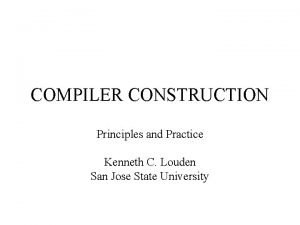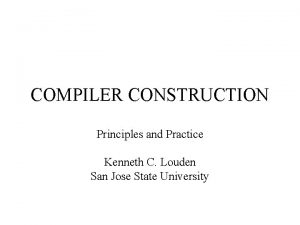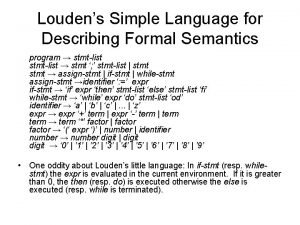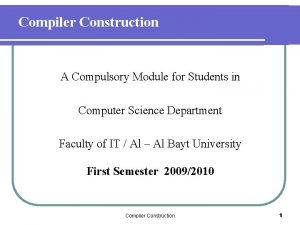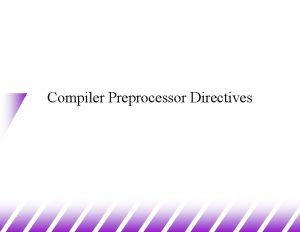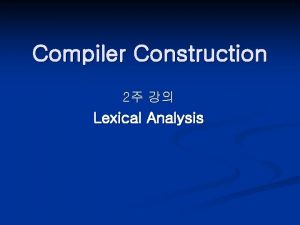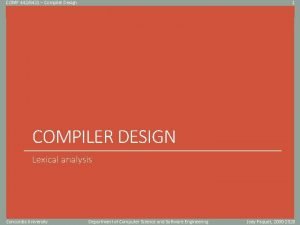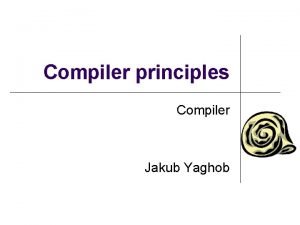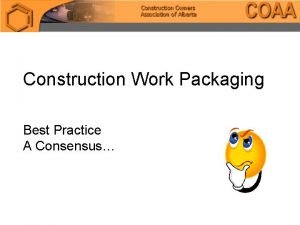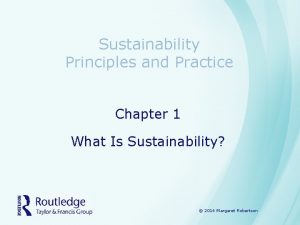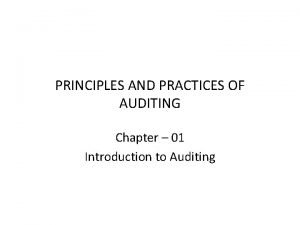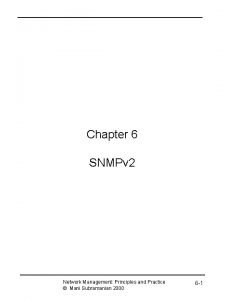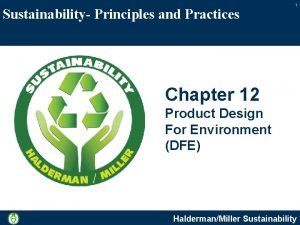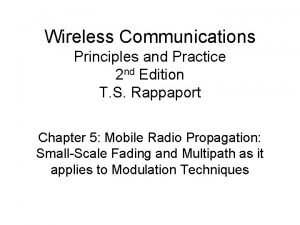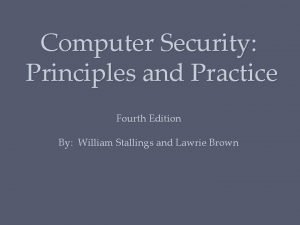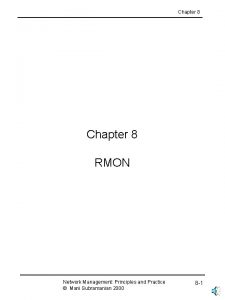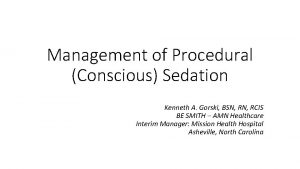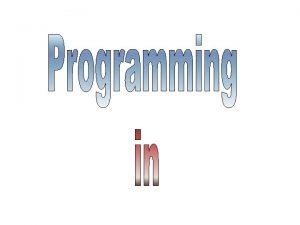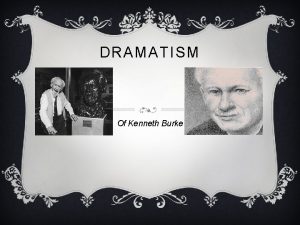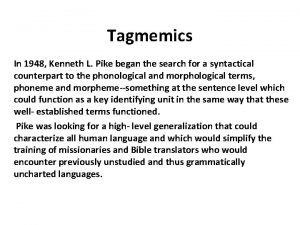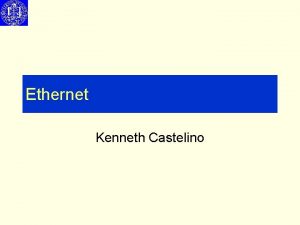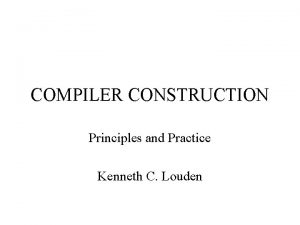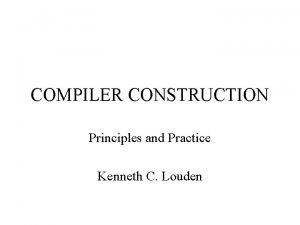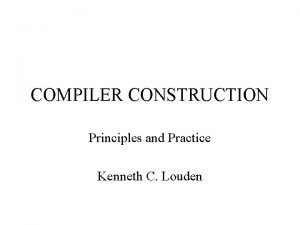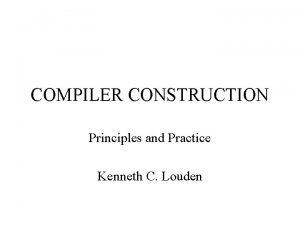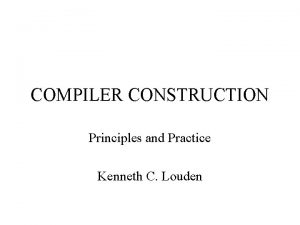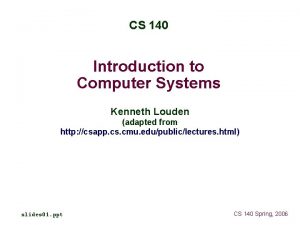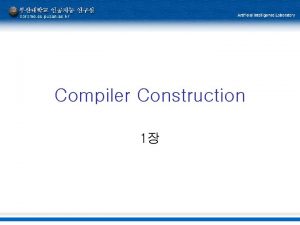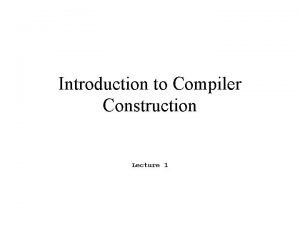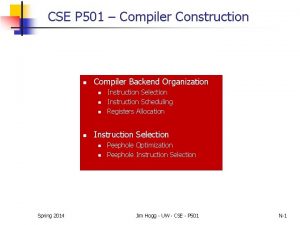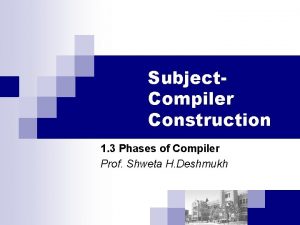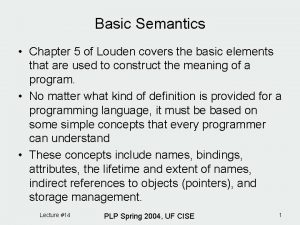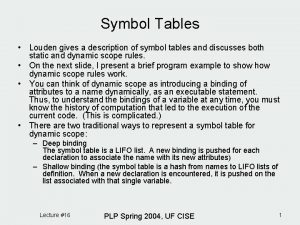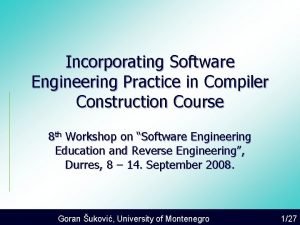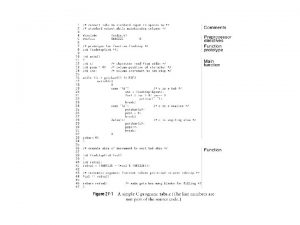COMPILER CONSTRUCTION Principles and Practice Kenneth C Louden











































![• For instance, in the code (in C syntax) int i; int a[10]; • For instance, in the code (in C syntax) int i; int a[10];](https://slidetodoc.com/presentation_image/498a90a588df85d03e37a83ce08d8f11/image-44.jpg)





- Slides: 49

COMPILER CONSTRUCTION Principles and Practice Kenneth C. Louden

7. Runtime Environments PART TWO

Contents Part One 7. 1 Memory Organization During Program Execution 7. 2 Fully Static Runtime Environments 7. 3 Stack-Based Runtime Environments Part Two 7. 4 Dynamic Memory 7. 5 Parameter Passing Mechanisms 7. 6 A Runtime Environment for the TINY Language

7. 4 Dynamic Memory

7. 4. 1 Fully Dynamic Runtime Environments

• A stack-based environment will result in a dangling reference when the procedure is exited if a local variable in a procedure can be returned to the caller The simplest example: Int * dangle(void) { int x; return &x; } Where, the address of a local variable is returned. • An assignment addr = dangle( ) now cause addr to point to an unsafe location in the activation stack

• A somewhat more complex instance of a dangling reference occurs if a local function can be returned by a call Typedef int(* proc)(void); Proc g(int x) {int f(void) /*illegal local function*/ {return x; } return f; } main() { proc c; c= g(2); printf(“%dn”, c()); /* should print 2*/ return 0; }

• Of course, C language avoids the above problem by prohibiting local procedure • Other languages, like Mudula-2, which have local procedures as well as procedure variables, parameters, and returned values, must state a special rule that makes such program erroneous • In the functional programming languages, such as LISP and ML, the functions must be able to be locally defined, passed as parameters, and returned as results.

• Thus, a stack-based runtime environment is inadequate, and a more general form of environment is required, called Fully Dynamic Environment • In fully dynamic environment, the basic structure of activation record remains the same: – The space must be allocated for parameters and local variables, and there is still a need for control and access links • When control is returned to the caller, the exited activation record remains in memory, to be de-allocated at some later time

7. 4. 2 Dynamic Memory in Object-Oriented Languages

• OO language requires special mechanisms in the runtime environment to implement their added features: – Objects, methods, inheritance, and dynamic binding • OO languages vary greatly in their requirements for the runtime environment. • Two good representatives of the extreme: – Smalltake requires fully dynamic environment; – C++ retains the stack-based environment of C in much of its design efforts.

• Object in memory can be viewed as a cross between a traditional record structure and an activation record • One mechanism would be for initialization code to copy all the currently inherited features (and methods) directly into the record structure (with methods as code pointer); • An alternative is to keep a complete description of the class structure in memory at each point during execution, with inheritance maintained by superclass pointers, and all method pointers kept as field in the class structure (Inheritance graph). • Another alternative is to compute the list of code pointers for available methods of each class, and store this in (static) memory as a virtual function table. It is the method of choice in C++.

Example: Consider the following C++ class declarations: Class A {public: double x, y; void f(); virtual void g(); } class B : public A {public: double z; void f(); virtual void h(); }


7. 4. 3 Heap Management

• In most language, even a stack-based environment needs some dynamic capabilities in order to handle pointer allocation and de-allocation • HEAP, the data structure to handle such allocation. • Allocated as a linear block of memory, which provides two operations: (1) Allocate, which takes a size parameter and returns a pointer to a block of memory of the correct size, or a null pointer if none exists. (2) Free, which takes a pointer to an allocated block of memory and marks it as being free again

• These two operations exist under different names in many languages: New and dispose in Pascal; New and delete in C++; Malloc and free in the C language. • A standard method for maintaining the heap and implementing these functions: (1) A circular linked list of free blocks; (2) Memory is taken by malloc; (3) Memory is return by free. • The drawbacks: (1) The free operation can not tell if the pointer is legal or not; (2) Care must be taken to coalesce blocks; otherwise, the heap can quickly become fragmented.

• A different implementation of malloc and free, using a circular linked list data structure that keep track of both allocated and free block. • The code is given in the following figures: #define NULL 0 #define MEMSIZE 8096 /* change for different sizes */ typedef double align; typedef union header {struct { union header *next; unsigned usedsize; unsigned freesize; } s; align a; } header; static header men[MEMSIZE]; static header *memptr=NULL;

void *malloc(unsigned nbytes) {header *p, *newp; unsigned nunits; nunits = (nbytes+sizeof(header)-1)/sizeof(header)+1; if (memptr == NULL) { memptr->s. next = memptr = mem; memptr->s. usedsize = 1; memptr->s. freesize = MEMSIZE-1; } for(p=memptr; (p->s. next!=memptr) && (p->s. freesize <nunits); p=p->s. next);

if (p->s. freesize < nunits) return NULL; /* no block big enough */ newp =p +p->s. usedsize; newp->s. usedsize = nunits; newp->s. freesize =p->s. freesize –nunits; newp->s. next = p->s. next; p->s. freesize=0; p->s. next = newp; memptr = newp; return (void *) (newp+1); }

void free(void *ap) { header *bp, *prev; bp = (header *)ap – 1; for (prev=memptr, p=memptr->s. next; (p!=bp) && (p!=memptr); prev=p, p=p>s. next); if (p!=bp) return; /* corrupted list, do nothing */ prev->s. freesize +=p->s. usedsize + p->s. freesize; prev->s. next = p->s. next; memptr = prev; }





7. 4. 4 Automatic Management of the heap

• The use of malloc and free to perform dynamic allocation and de-allocation of pointer is called manual method. • By contrast, the runtime stack is managed automatically by the calling sequence. • Garbarge collection: the process of reclamation of allocated but no longer used storage without an explicit call to free. • The standard technique is to perform mark and sweep garbage collection. • In this method no memory is freed until a call to malloc fails, which does this in two passes. – Follows all pointers recursively, starting with all currently accessible pointer values and marks each block of storage reached; an extra bit for the marking. – Sweeps linearly through memory, returning unmarked blocks to free memory. – Also perform memory compaction to leave only one large block of contiguous free space at the other end.

• The Mark and Sweep garbage collection has several drawbacks: – Requires extra storage; – The double pass through memory cause a significant delay in processing • A bookkeeping improvement can be made to this process by splitting available memory into two halves and allocating storage only from one half at a time. • Called stop-and-copy or two-space garbage collection. – All reached blocks are immediately copied to the second half of storage not in use; – No extra mark bit is required and only one pass is required; – It also performs compaction automatically; – It does little to improve processing delays during storage reclamation.

• Generational garbage collection, which adds a permanent storage area to the reclamation scheme of the previous paragraph • Allocated objects that survive long enough are simply copied into permanent space and are never deallocated during subsequent storage reclamations. • Search only a very small section of memory for newer storage allocations, and the time for such a search is reduced to a fraction of a second.

7. 5 Parameter Passing Mechanisms

• In a procedure call, parameters correspond to location in the activation record which will be filled by the caller with the arguments before jumping to the code of the called procedure • The process of building these values is sometimes referred to as the binding of parameters to the arguments • How the argument values are interpreted by the procedure code depends on the particular parameter passing mechanisms adopted by the source language – Fortran 77 binds parameter to locations rather than values; – C views all arguments as values; – C++, Pascal and Ada, offer a choice of parameter passing mechanisms.

• The common parameter passing mechanisms: – – Pass by value Pass by reference Pass by value-result Pass by name (also called delayed evaluation) • Other issues not addressed by the parameter passing mechanism itself: – The order in which arguments are evaluated – Many languages permit arguments to calls that cause side effects • Example: f(++x, x); – C compilers evaluate their arguments from right to left

7. 5. 1 Pass by Value

• The arguments are expressions that are evaluated at the time of the call, and their values become the values of the parameter during the execution of the procedure The only parameter passing mechanism available in C; The default in Pascal and Ada • The following inc 2 function written in C does not achieve its desired effect: Void inc 2( int x) /* incorrect ! */ { ++x; }

• In order to achieve non-local changes, In C, this takes the form of passing the address instead of the value: Void inc 2(int *x) /* now ok */ {++(*x); } • Pass by value require no special effort on the part of the compiler • It is easily implemented by taking the most straightforward view of argument computation and activation record construction

7. 5. 2 Pass by Reference

• Pass-by-reference passes the location of the variable, so that the parameter becomes an alias for the argument. – The only parameter passing mechanism in Fortran 77; – In pascal, pass by reference achieved with the use of var keyword; – In c++, by the use of special symbol & in the parameter declaration: Void inc 2( int & x) /* C++ reference parameter */ {++x; ++x} • Pass by reference requires the compilers to compute the address of the argument to store in the local activation record. • The compile must also turn local accesses to the reference parameter into indirect access modes.

• For the call like p(2+3) in the FORTRAN 77, a compile must invent an address for the expression 2+3, compute the value into this address, and then pass the address to the call • The features of pass by reference: – Not require a copy to be made of the passed value, which is significant for a large structure. – Pass an argument by reference and prohibit changes to be made to the argument’s value. Such an option is provide by C++ • Void f (const muchdata & X) – Where, muchdata is a data type with a large structure, the compile will perform a static check the X never appears on the left of an assignment.

7. 5. 3 Pass by Value-Result

• The mechanism achieves a similar result to pass by reference, except that no actual alias is established , Known as copy-in, copy-out, or copy-restore – This is the mechanism of Ada in out parameter • Pass by value-result is only distinguishable from pass by reference in the presence of aliasing. • For instance, in the following code(in C syntax), Void p(int x, int y) { ++x; ++y; } main( ) { int a=1; p(a, a); return 0; } • If pass by reference is used, a has value 3 after p is called, while • If pass by value-result, a has value 2 after p is called.

• The unspecified issues in this mechanism: – The order in which results are copied back to the arguments; – The locations of the arguments are calculated only on entry or recalculated on exit. • Pass by value-result needs to modify the basic structure of the runtime stack and the calling sequence: – The activation record cannot be freed by the callee – The caller must either push the address of arguments onto the stack before constructing the new activation record, or recomputed these address on return from the called procedure.

7. 5. 4 Pass by Name

• This is the most complex of the parameter passing mechanisms, which is also called delayed evaluation. • Idea: the argument is not evaluated until its actual use in the called program • As an example, in the code: Void p (int x) { ++x; } • The effect of p(a[i]) is of evaluating ++(a[i]) • Thus if i were to change before the use of x inside P, the result will be different from either pass by reference or pass by value-result.
![For instance in the code in C syntax int i int a10 • For instance, in the code (in C syntax) int i; int a[10];](https://slidetodoc.com/presentation_image/498a90a588df85d03e37a83ce08d8f11/image-44.jpg)
• For instance, in the code (in C syntax) int i; int a[10]; void p(int x) {++i; ++x; } main() { i=1; a[1]=1; a[2]=2; p(a[i]); return 0; } • The result of the call p(a[i]) is that a[2] is set to 3 and a[1] is left unchanged.

• The interpretation of pass by name is as follows: – The text of an argument at point of call is viewed as a function in its own right. – The arguments are evaluated every time the parameter name is reached in the procedure. – The arguments are evaluated in the caller’s environment, while the procedure will be executed in its defined environment • Pass by name mechanism was used in the language Algol 60, which became unpopular for several reasons: – Gives surprising and counterintuitive results in the presence of side effects; – Difficult to implement; – Inefficient. • A variation on this mechanism called lazy evaluation has recently become popular in purely functional languages

7. 6 A Runtime Environment For The TINY Language

• The TINY has no procedure, and all of its variables are global, so that there is no need for a stack of activation records, • And the only dynamic storage necessary is that for temporaries during expression evaluation • Given a program that used, say, four variables x, y, z and w, these variables would get the absolute address o through 3 at the bottom of memory, • And at a point during execution where three temporaries are being stored


End of Part Two THANKS
 Kenneth c. louden
Kenneth c. louden Compiler
Compiler Louden language
Louden language Lex yacc example
Lex yacc example Cross compiler in compiler design
Cross compiler in compiler design Type checker in compiler design
Type checker in compiler design Phases of compiler construction
Phases of compiler construction Explain compiler construction tools
Explain compiler construction tools What is frontend and backend of compiler
What is frontend and backend of compiler Preprocessor in compiler construction
Preprocessor in compiler construction Interpreter in compiler construction
Interpreter in compiler construction Attributes of tokens in compiler design
Attributes of tokens in compiler design Thompson construction in compiler design
Thompson construction in compiler design Compiler
Compiler Construction management standards of practice
Construction management standards of practice Construction work package software
Construction work package software Myeplg website
Myeplg website Conservative principle of curriculum
Conservative principle of curriculum Recommendation of mudaliar commission chart
Recommendation of mudaliar commission chart Fundamental principles of ship construction
Fundamental principles of ship construction Sustainability principles and practice
Sustainability principles and practice Main objective of auditing
Main objective of auditing Computer security principles and practice
Computer security principles and practice Computer security principles and practice solutions
Computer security principles and practice solutions Augmented reality: principles and practice
Augmented reality: principles and practice Tourism principles and practice
Tourism principles and practice Network management principles
Network management principles Sustainability principles and practice
Sustainability principles and practice Computer security principles and practice 4th edition
Computer security principles and practice 4th edition Network management principles
Network management principles Sircim
Sircim Computer security principles and practice
Computer security principles and practice Rmon in network management
Rmon in network management Rosen discrete mathematics solutions
Rosen discrete mathematics solutions Dr kenneth gorski
Dr kenneth gorski Kenneth nelson sofi
Kenneth nelson sofi Kenneth lane thompson
Kenneth lane thompson Kenneth himma
Kenneth himma John kenneth ferrier
John kenneth ferrier Kenneth ott ecommerce
Kenneth ott ecommerce Dramatism kenneth burke
Dramatism kenneth burke Kenneth malmberg
Kenneth malmberg Dr kenneth wang
Dr kenneth wang Kenneth røn christiansen
Kenneth røn christiansen Tagmemic model ni kenneth pike
Tagmemic model ni kenneth pike Kenneth castelino
Kenneth castelino Sangrado rojo rutilante
Sangrado rojo rutilante Kenneth ellerbee
Kenneth ellerbee Eric bohn md
Eric bohn md Kenneth sockwell apple valley ca
Kenneth sockwell apple valley ca
